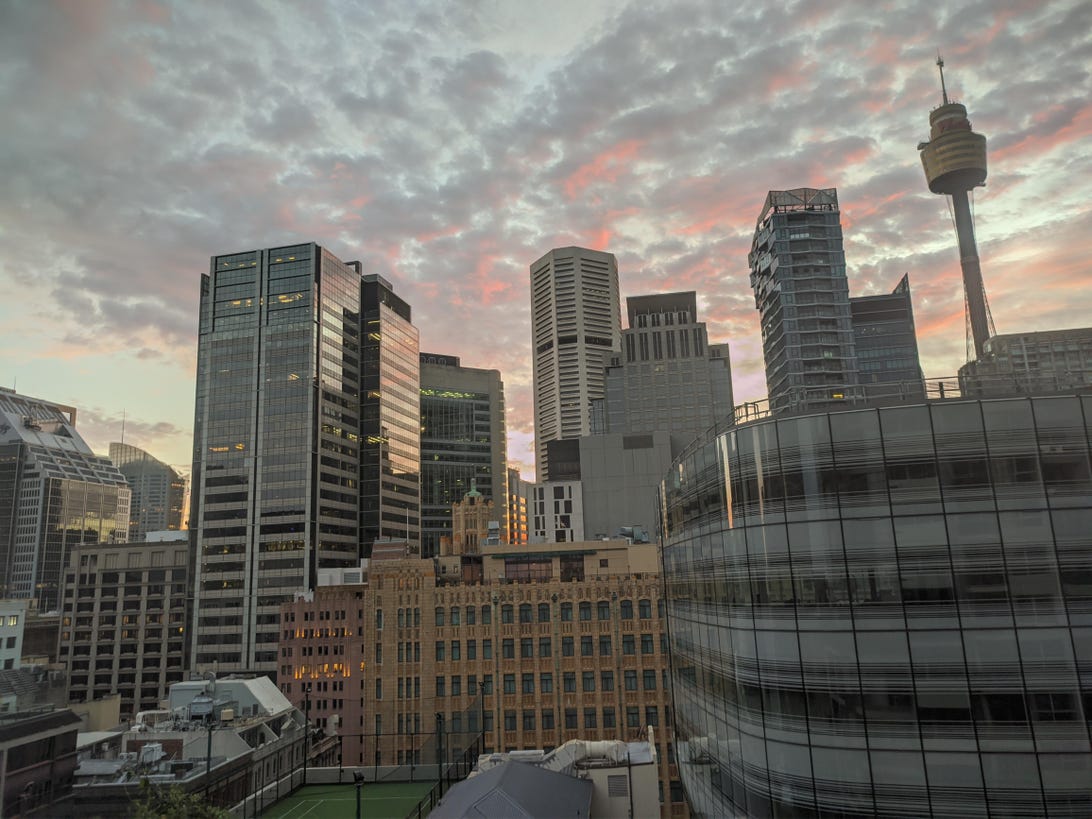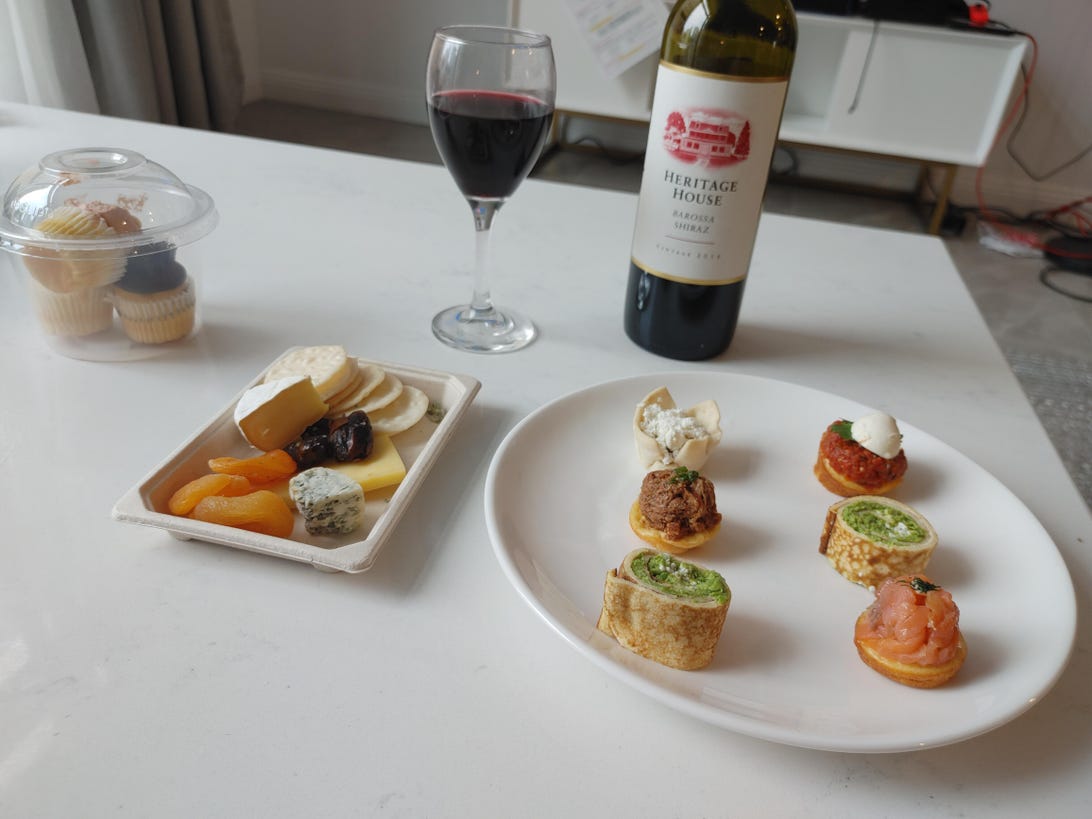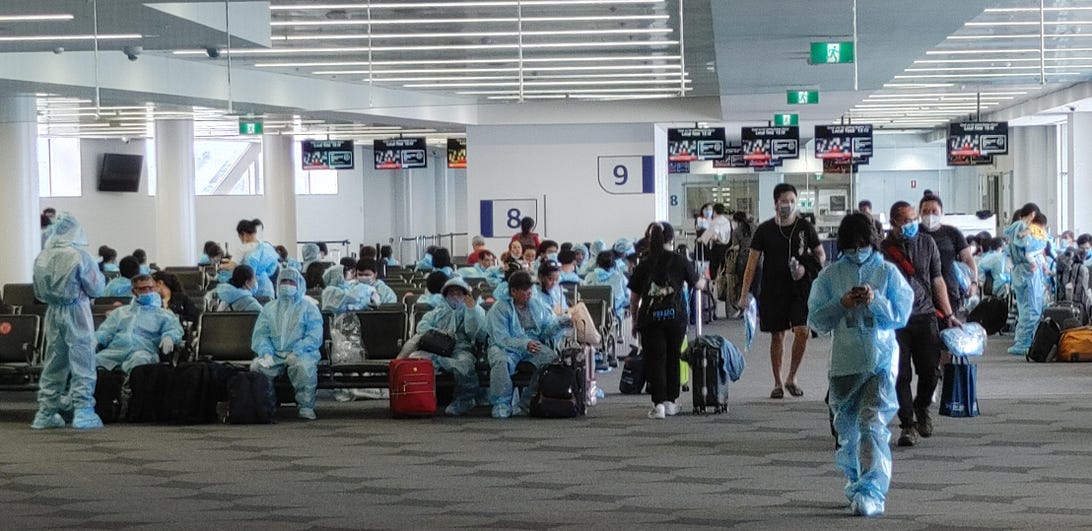
Sydney, Australia: A world away and COVID-19 free
Ty Pendlebury/CNETAfter a long year of pandemic lockdowns, closures and empty streets at rush hour, normality is clawing its way back into our lives in the US. Restaurants and schools are kind of reopening, movies are showing in cinemas and foot traffic has returned to the streets of Manhattan. With the rollout of three vaccines designed to prevent the worst effects of COVID-19, returning to life as usual is possible within a year, according to the Centers for Disease Control and Prevention.
That's the dream, yet in some countries life actually appears weirdly normal right now. In Australia and New Zealand, people are going to concerts, the cinema and restaurants with no mask in sight. While these island nations haven't been immune to COVID, by clamping down on overseas visitors, enforcing strict lockdowns and conducting extensive contract tracing, they've practically wiped the illness out. Though Australia has a similar population to the state of Texas, the country has not recorded a coronavirus-related death since October.
No one wants to travel internationally right now, especially to Australia, which has one of the toughest quarantines in the world. Yet in late December, just as the disease was peaking worldwide, I traveled to the country of my birth from New York. With a kid in tow, a trip halfway across the world would be a challenge in the best of times, but in a pandemic the hurdles were that much higher. I never envisioned spending New Year's Eve sounding party whistles within earshot of a government guard, but that's only one of the side effects of flying at the height of a global lockdown.
Read more: Australia offers a strange glimpse of life post-pandemic
Leaving New York, never easy

Most flights had plenty of empty seats to maximize social distancing.
Ty Pendlebury/CNETBetween airport security and cramped seats, air travel has long been a humbling experience. Throw in a once-in-a-lifetime pandemic, however, and the thought of air travel was downright nightmarish -- my wife and I were extremely apprehensive in the weeks leading up to our flight. If I had my druthers I wouldn't have flown 10,000 miles with my family, all of us enduring the 22-hour trip each way, locked into a metal tube with dozens of potentially infected strangers. We needed to travel for personal reasons, however, and had little choice.
With some exemptions, such as tennis players attending the Australian Open, there is a limit to the number of international travelers who are permitted to enter Australia. As Australian citizens, my family and I were fortunate to make the cut, but regardless, all incoming passengers also have to quarantine in a hotel room for 14 days and test negative for COVID-19 before we're allowed to leave.
After our self-imposed 10-day quarantine at home in preparation, getting through security and onto the plane at Newark Airport was uneventful -- the terminal was mostly deserted. Apart from our nervousness in ensuring we had all of our necessary paperwork, we were able to board our first flight to San Francisco. The plane, like most transport I've used in the past 12 months, was only around a quarter full. You had to throw something if you wanted to grab a fellow passenger's attention. We deplaned and spent a couple hours waiting in the spookily empty SF terminal. Most of the restaurants and shops were closed on a Tuesday evening, but I managed to find a place selling sake and sushi hand rolls. We ate these while waiting to reboard and watched our kid perform overtired contortions on the carpeted floor.
Despite our paranoia about breathing in recycled air, there were only two notable things that happened in the next 13 hours. The first was watching the excellent The Personal History of David Copperfield (seriously, check it out); the second was witnessing our air steward have a coughing fit in the galley without a mask. Minutes later he was bringing me a drink. "Oh God, this is it!" I thought. I made a mental note of where I was on the plane and the flight number for the inevitable news article when I got to Australia. But then we arrived in Sydney and our trip really began.
After landing and disembarking, we went through customs, collected our bags and headed through what can only be called a number of military checkpoints. When we approached the first, my kid decided she wanted to go for a wander into a cordoned-off part of the airport, in full view of the soldiers in surgical masks. No doubt they'd seen this kind of behavior before, and sometimes people can manage to escape security completely -- in November, a couple managed to flee Melbourne airport, resulting in a huge scandal. The soldiers greeted my kid with a gruff, "Come back here!" and after some panicked shouts from her embarrassed parents she sauntered back. From there, under the watchful eyes of both police and soldiers, we were led through a corridor, past a huge display of AU$1 SIM cards (I grabbed a handful), and into a parking lot.
There were two buses, one for people traveling solo and one for families. Eventually, with a police escort in place, our bus proceeded to two different hotels, one on the border of the airport to drop off some of our fellow passengers, and finally ours, in the middle of Sydney's central business district. Our two-week quarantine had begun.
Our lovely hotel prison
We "checked in" at the lobby downstairs surrounded by police and Australian Defence Force soldiers. The hotel was half a mile from the Sydney Opera House, so I thought it would be nice if we could see the New Year's Eve fireworks from our window. I felt rude asking for a Harbour Bridge view, however, especially with another father checking in his family next to me. We would get what we get and not get upset.

We had a lovely view of my old Sydney office.
Ty Pendlebury/CNETOur room faced southeast instead of the hoped-for view north toward the harbor, but we still had a decent vista. We could see the rebuilt Coke sign in the Kings Cross nightlife district, which has been shuttered by lockout laws and the coronavirus, and the tallest buildings of Sydney's Chinatown.
The room itself was decent, with a separate lounge and bedroom and a kitchenette, and while we only cooked once or twice, we nevertheless ate well. The two weeks were catered with a set menu of microwavable meals (vegetarian/gluten-free optional) which weren't bad at all, and we had a mountain of fruit and dinner rolls by the end of the 14 days. We had a nurse and a counsellor on call if we were sick or the quarantine was grinding us down. In short, we were looked after.
But we were still basically prisoners. We had a guard stationed in the hallway on our floor. We could see him if we popped our heads out the door but we daren't go into the passageway. I could only make out half of his face, but I could smell him before I saw him anyway -- he liked using strong antiperspirants. The window opened a small crack for airflow, but we never felt like we were a part of the city outside.
Apart from the guard, the only other humans we saw for the next two weeks were the backs of delivery people and the nurses administering our two COVID tests.

With no real ability to exercise we kept ourselves busy with Just Dance on the Nintendo Switch.
Ty Pendlebury/CNETThe past 12 months in the US have made me feel quite withdrawn, and quarantine only amplified the feeling. When I saw someone sitting outside on the street under my hotel window one day I didn't think in rational terms. I wondered idly if I could hit him with something from our perch on the 15th floor -- a paper plane or a piece of cork squeezed through the crack in the window. Certainly not a loogie. I'm not an animal.
Our first week was over the holiday break, and we filled our time with Australian TV shows like the children's program Bluey. From that we learned the game of keepy-uppy -- keeping a balloon off the ground for as long as you can -- which came to be one of our main pastimes. That and making paper dolls, playing boxing games on the Switch and booze. So much booze, but only beer and wine deliveries were allowed. My sister joked about baking us a cake with a bottle of vodka inside it.

An unexpected New Year's Eve platter, plus wine.
Ty Pendlebury/CNETWe had spent Christmas Day at home in New York -- Santa would be confused if we were suddenly in another country, we told our kid -- but despite being in quarantine for New Year's Eve we did get a lovely surprise. A care package from the hotel appeared at our door that afternoon with whistles, balloons and a lovely platter of canapes. With the food situation handled we didn't make it too far into the evening -- we were awake for the 9 p.m. "kids" fireworks display and saw one of the three major displays south of us. Though we were a mile away, we still oohed and ahhed when we saw a pink or purple bloom. My wife stayed up longer than me and saw a couple of flashes in the hotel windows across the way, but that was it. I was happy to watch it the next day on YouTube.
We were due to be released from quarantine on Jan. 11, which meant that we experienced the events of Jan. 6 from 10,000 miles away. When the rioters broke through the windows of the Capitol at 2:11 p.m. in Washington, DC, it was still breakfast time for us, and we watched the events unfold through the prism of Twitter over the course of the day. We'd been in a relative news vacuum the past week, but we didn't share what was happening with our kid. I felt a mixture of confusion, anger and hopelessness that I couldn't adequately convey to her.
Freedom, of a sort
The day we left quarantine was also the first day of CES, which meant a long day of work for me. After having been awake most of the night, my last press conference was at 9 a.m. Sydney time, and an hour later two soldiers arrived to take us downstairs and supposedly let us free. But since our ultimate destination was Melbourne, our journey wasn't over yet.
The border between New South Wales and Victoria was closed to contain one recent infection, and yet we could cross if we went straight from the hotel to the airport. Spending any time in Sydney at all meant we would have to go into another hotel quarantine. Gah! Helpfully, reception told us that we could take a taxi from a preapproved cab company and they'd call one for us. When the taxi appeared its driver greeted us with a smile, completely unmasked.
In my head, there was a record scratch and a "crowd gasping" sound effect. "It doesn't matter," the driver tells us. We told him in so many words that we didn't spend nine months inside in the US, and 14 days in hotel quarantine, to get COVID from his stupid ass, so could he please put a mask on? He pulled one out of his hip pocket for use in such situations, apparently a common tactic in Australia. Not especially reassured, I rode with my window down the whole way.
Of the four flights we took on the trip -- two international and two within Australia -- the most surreal were the ones landing in Australian cities. Ordinarily, disembarking an airplane on a tarmac always makes me feel like a rockstar, like a Beatle or a head of state. But on this hot January day after flying from Sydney to Melbourne on a cut-rate airline called Jetstar, what awaited us wasn't hordes of adoring fans. Instead it looked like a scene from the movie Outbreak.
With social distancing requirements in place, the 50 people from our flight were made to file through those weird, taped-off mazes inside the terminal. Blocking our exit were an equal number of people dressed in light-blue scrubs with masks, face shields and clipboards. It was like the world's slowest, most lopsided football game and the other team had the ball.

There were temperature checks like this at the closed border between New South Wales and Victoria.
PeopleImages/Getty ImagesBut as we approached it appeared it was merely a case of hygiene theater. We were asked a couple of rudimentary questions and had our temperatures taken. Behind them a lone cameraperson was filming the people filing off the plane and through the medical personnel. News at 11.
The first few days out of quarantine, living in a country with basically no COVID, were bizarre. We'd spent the last nine months living in the US' first major COVID-19 epicenter, which impressed upon me the need for both social distancing and wearing a mask.
But it wasn't long before the alternate reality sank in. On the news that night was a bulletin about a COVID hotspot that had emerged in Australia, but over 1,000 miles away. The reporter named a cafe involved, and that there were a handful of cases as a result. It was read in the breathless way that "killer on the loose" bulletins are, which boggled my New York mind. I couldn't imagine anything like this report occurring in the US, where every place is just as dangerous as any other, where thousands of new cases occur every day and Americans take it all for granted.
The lessons we learned from New York stayed with us. For two weeks we were conspicuously the only people wearing masks walking down the street, though everyone kept a mask on them for places it was mandated -- public transport or the Apple Store. We visited family and friends; my kid fed a wild emu, which didn't eat her; we went to a huge bar full of people not wearing masks (that was freaky); we swam in the ocean; and we even went to the cinema. It gave us a glimpse of what the US will hopefully be like by 2022, or even sooner if the vaccine rollout continues on pace.

A day at the movies.
Ty Pendlebury/CNETAs we got ready to fly back to the US, my kid told me she didn't want to leave. We were in the middle of summer, our family was there and there was no boogeyman waiting to snatch us. New York, meanwhile, was expecting inches of snow that week and experiencing some of its worst days in terms of infections and deaths.
The day before we left to return home, the US announced incoming passengers needed to show proof of a negative COVID test before entering the country. No exceptions. At the airport, my wife went to a separate desk to show our COVID results while I headed through another doorway to prove that we lived in the US.

Passengers wait at Sydney airport for a Vietnam Airlines flight.
Ty Pendlebury/CNETAhead of me in the Travel Exemption line were about five people. A woman toting a baby in a papoose-like wrap was crying as she spoke to the agents at the front of the line. She was trying to fly home to her husband, she said and, like all of us in line, didn't realize there was one more hurdle before we could use the tickets we had paid for.
"You can't leave just because you're homesick," the officers were telling her.
Like us, she lived in another country, regardless of what her passport said. When it was our turn to talk to the agents I showed them my papers and we were granted the stamp that let us leave. As I left towards the security gates I wondered how the woman and her infant would fare.
Back to reality
We are safely back in New York after completing another 10 day in-home quarantine. I am grateful we jumped through all of the administrative hoops to fly back to Australia, which is expected to continue the program through June and potentially beyond. As the Northern Hemisphere begins to thaw with the start of spring, there are hints of what life will one day be like.
My chosen country and my home country have both had world-leading strategies: one in containing the virus, and the other in combating it through vaccination. Experiencing both helped me realize this is a global problem. Borders will open again one day, but it will take time and effort to make things return to normal. I learned first-hand that going back to life as it was before involves some sacrifices, but it's worth it not to be terrified of the coronavirus during every waking moment.
"how" - Google News
March 28, 2021 at 06:00PM
https://ift.tt/31piGPI
How visiting a COVID-free country gave me hope for the future - CNET
"how" - Google News
https://ift.tt/2MfXd3I
Bagikan Berita Ini














0 Response to "How visiting a COVID-free country gave me hope for the future - CNET"
Post a Comment